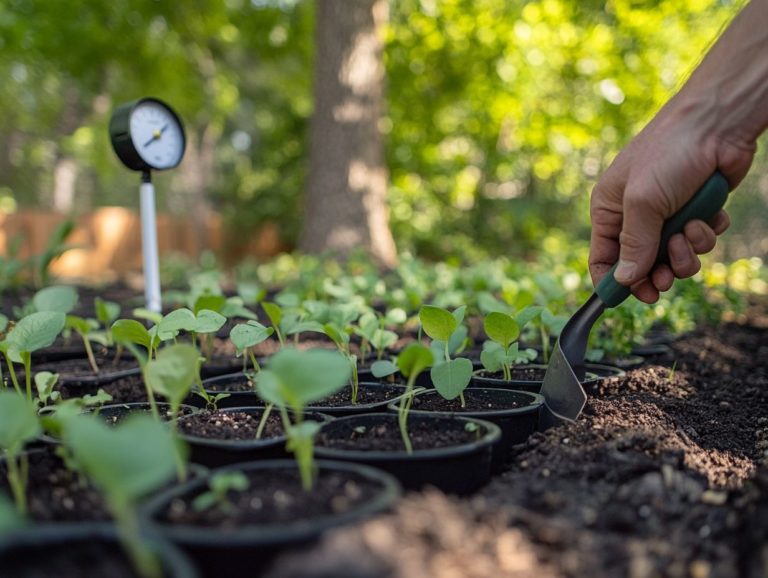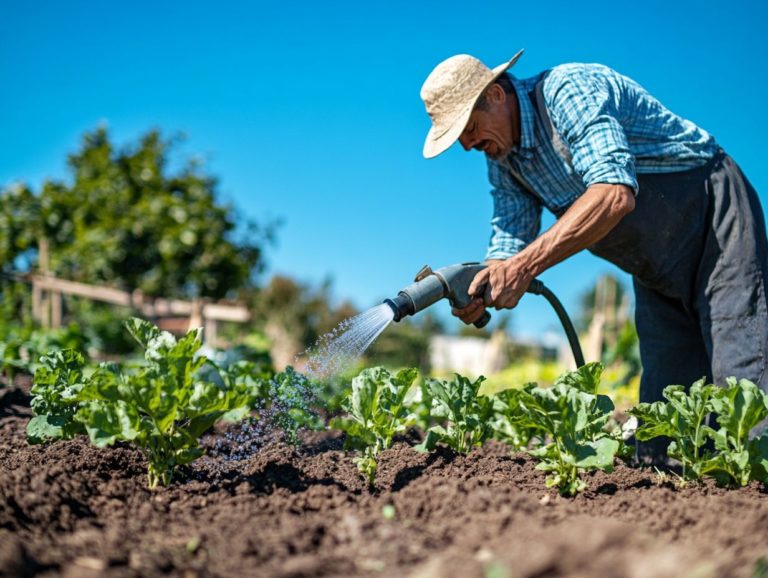Understanding Stress Signs in Plants
Stress in plants is more prevalent than you may realize. Recognizing its signs is vital for any gardener or plant enthusiast.
In this article, you’ll discover the visual indicators and behavioral changes that signal stress. We will explore the various environmental factors, diseases, and pests that contribute to it.
You ll find practical tips for prevention and management to keep your plants flourishing.
Discover the long-term effects of stress on plant health and learn effective strategies to revive any struggling greenery. Whether you re nurturing houseplants or tending to a garden, understanding plant stress will empower you to cultivate healthier, more resilient plants.
Contents
Key Takeaways:
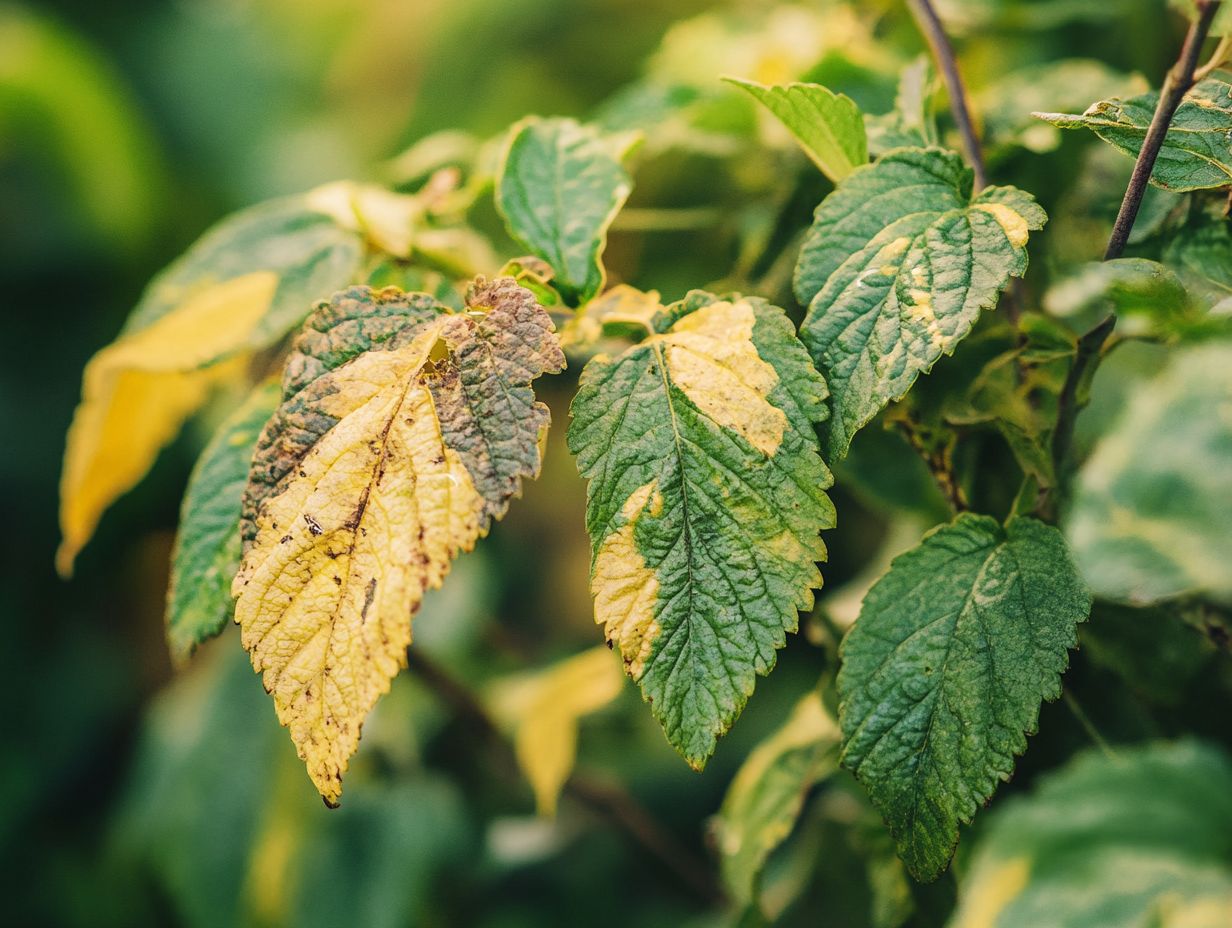
Defining Stress in Plants
Plant stress encompasses a range of conditions that hinder how plants grow and function. It is often triggered by environmental factors like nutrient deficiencies and temperature extremes.
You can categorize this stress into two primary types: stress from non-living things and stress from living things. Stress from non-living things involves factors like soil moisture, while stress from living things stems from pests and diseases.
Abiotic stressors can be quite the challenge. For example, cold stress can stifle growth by disrupting cellular functions in sensitive plant varieties.
Nutrient deficiencies can lead to poor photosynthesis and stunted development. On the flip side, biotic stressors, such as herbicide damage, can significantly impede plant metabolism and growth patterns.
An invasion of aphids, for instance, can drain vital nutrients or introduce diseases, further jeopardizing the health and productivity of your crops.
By effectively diagnosing and addressing these stress factors, you can elevate crop yields and foster sustainable practices.
Common Signs of Plant Stress
Recognizing the common signs of plant stress is crucial for effective plant care. Various visual indicators offer valuable insights into your plants’ health and can alert you to potential issues before they escalate.
Symptoms like wilting leaves, blackened foliage, and bleached tips often serve as early warning signs of underlying problems. These issues may arise from environmental factors or nutrient deficiencies.
By identifying these indicators, you empower yourself to take timely action, mitigating further damage and fostering the revival of your plants’ vitality.
Visual Indicators
Visual indicators are essential for diagnosing plant stress. They reveal a spectrum of conditions that can impact overall health.
For instance, wilting foliage can suggest insufficient soil moisture, a crucial factor for nutrient uptake and photosynthesis. Conversely, blackened leaves typically indicate various diseases, such as fungal infections, which can swiftly undermine a plant’s vitality.
Bleached foliage may signal overexposure to sunlight, resulting in chlorosis and diminished photosynthetic efficiency. Ragged edges on leaves may also indicate pest damage.
Ultimately, by paying close attention to these visual cues and grasping their significance, you can make informed decisions about interventions that will help restore and enhance plant health.
Start monitoring your plants today to catch stress early and enjoy a vibrant garden!
Behavioral Changes
Behavioral changes in plants often unveil the stressors lurking beneath the surface. These changes reflect their physiological responses to both abiotic and biotic stress conditions. For instance, when faced with nutrient deficiency, you might notice stunted growth or shifts in leaf color. Exposure to high salinity can disrupt water uptake.
These adaptations reveal the intricate signaling pathways plants employ to tackle environmental challenges. They showcase their remarkable resilience.
The negative impacts of temperature extremes are also evident. Plants may wilt or drop leaves in response to heat stress. Cold conditions can lead to cell damage and a slowdown in metabolic processes. Drought stress triggers specific changes in stomatal behavior, reducing transpiration rates to conserve water.
Each of these reactions highlights the complex interplay between a plant’s genetic makeup and its environment.
Understanding these behavioral modifications offers valuable insights into how plants navigate challenges. This ultimately informs agricultural practices designed to enhance crop resilience and sustainability.
Causes of Plant Stress
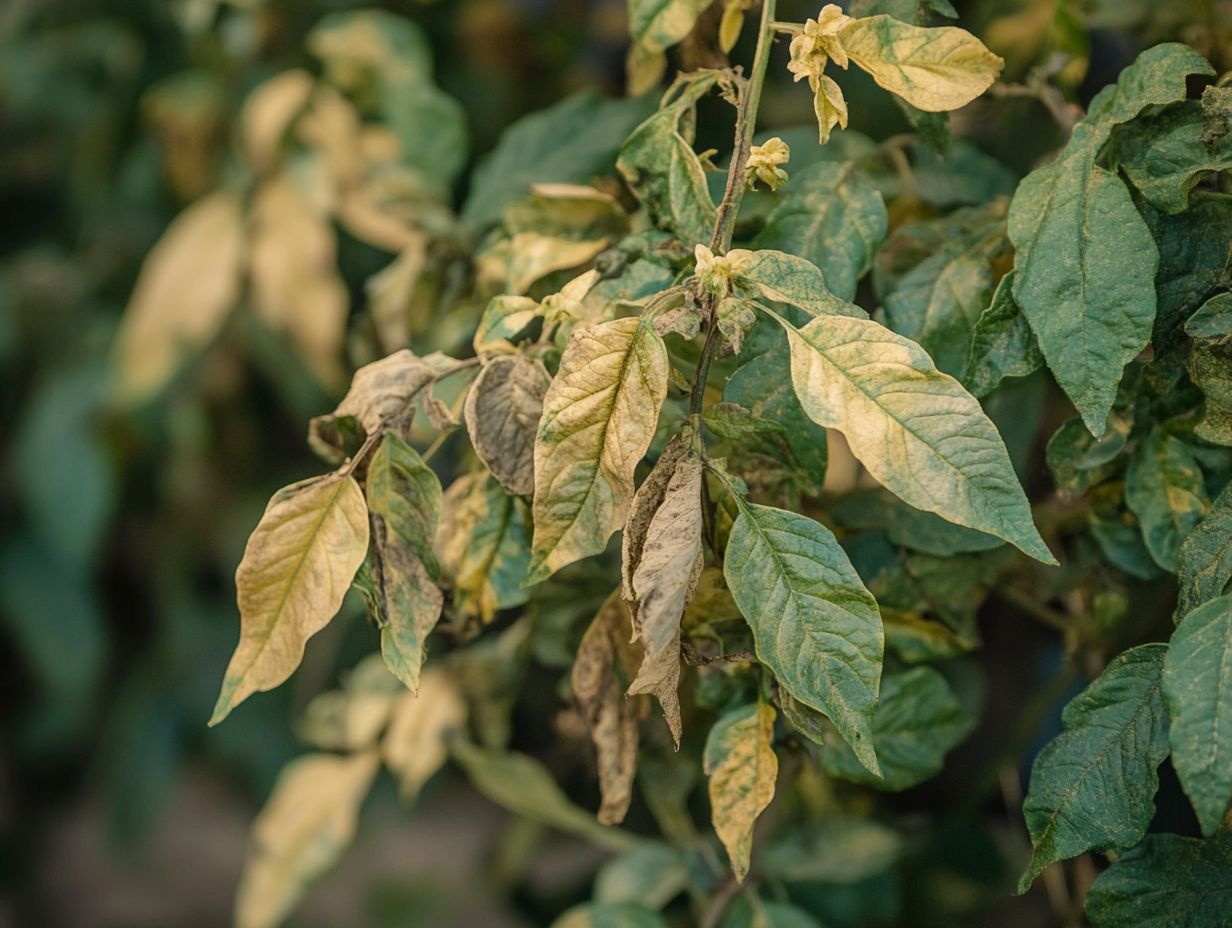
The causes of plant stress can be elegantly divided into environmental factors and biological influences. Both play crucial roles in the health and productivity of your plants.
Environmental factors such as temperature extremes, high salinity, soil moisture fluctuations, and air pollutants can induce significant stress caused by non-living factors. On the other hand, biotic stress emerges from pesky pests and diseases. These can potentially exacerbate the physiological challenges your plants encounter, leading to nutrient deficiencies and an overall decline in vigor.
Recognizing these stressors can save your plants from serious harm!
Environmental Factors
Environmental factors are pivotal in shaping plant health. They often lead to considerable stress when conditions turn unfavorable. Elements such as soil moisture, temperature fluctuations, high salinity, and air pollutants can disrupt normal physiological processes. This disruption can manifest as visible stress signs like wilting foliage or scorched leaves.
For example, insufficient soil moisture can severely impair a plant’s ability to absorb essential nutrients. This ultimately affects its growth and yield. Temperature extremes whether blistering heat or unexpected frost can inflict cellular damage. This may stunt development or, in dire cases, lead to death.
High salinity levels in the soil can disrupt osmotic pressure, complicating water uptake. Additionally, elevated air pollutants, such as ozone, can obstruct photosynthesis, further jeopardizing plant health.
These factors emphasize the necessity of vigilant monitoring and management of environmental conditions to ensure plants thrive with vitality.
Disease and Pests
The influence of diseases and pests on plant health often indicates biotic stress. This stress can have devastating effects on your crop productivity and quality. When faced with disease, plants show symptoms that vary depending on the pathogen involved. Pests inflict damage through feeding, making plants even more vulnerable to additional infections.
Identifying the specific pathogens and pests is your first step in mitigating their detrimental effects. Keep an eye out for telltale signs such as wilting, discoloration, or unusual growth patterns that may hint at underlying issues.
Advanced techniques, such as molecular diagnostics, can provide deeper insights into the exact threats facing your crops.
To tackle these challenges head-on, consider an integrated pest management approach. This should incorporate biological controls, crop rotation, and resistant plant varieties. By fostering an ecosystem that encourages natural predators while closely monitoring for signs of distress, you can enhance plant resilience and safeguard your yields.
Take action today to protect your plants from stress!
Preventing and Managing Plant Stress
Preventing and managing plant stress is vital for maintaining healthy crops and fostering optimal growth conditions. By implementing best practices like soil testing, employing appropriate watering techniques, and utilizing fertilizers, you can effectively mitigate stress caused by environmental factors.
Furthermore, exploring genetic modification (changing a plant’s DNA to improve its traits) may provide you with innovative solutions to enhance your plants’ resilience against both non-living and living stress factors, paving the way for sustainable agricultural practices.
Best Practices for Plant Care
Implementing best practices for plant care is essential for preventing stress and ensuring vigorous growth in your crops. Techniques such as maintaining optimal soil moisture levels, regularly applying fertilizers, and monitoring environmental factors can significantly minimize the risk of plant stress, resulting in healthier and more resilient plants.
To achieve this, it’s crucial to regularly assess soil conditions. Make adjustments to your watering routines accordingly, ensuring that moisture levels are just right not too high and not too low.
Using the right type of fertilizer whether organic or synthetic at appropriate intervals will provide the essential nutrients your plants need for robust growth. By observing the specific needs of your plants in relation to their environment, you gain the power to make informed decisions and take effective actions. Integrating these practices into your routine allows you to cultivate thriving greenery that flourishes in health and elevates the vitality of your entire garden.
Effective Treatment Methods
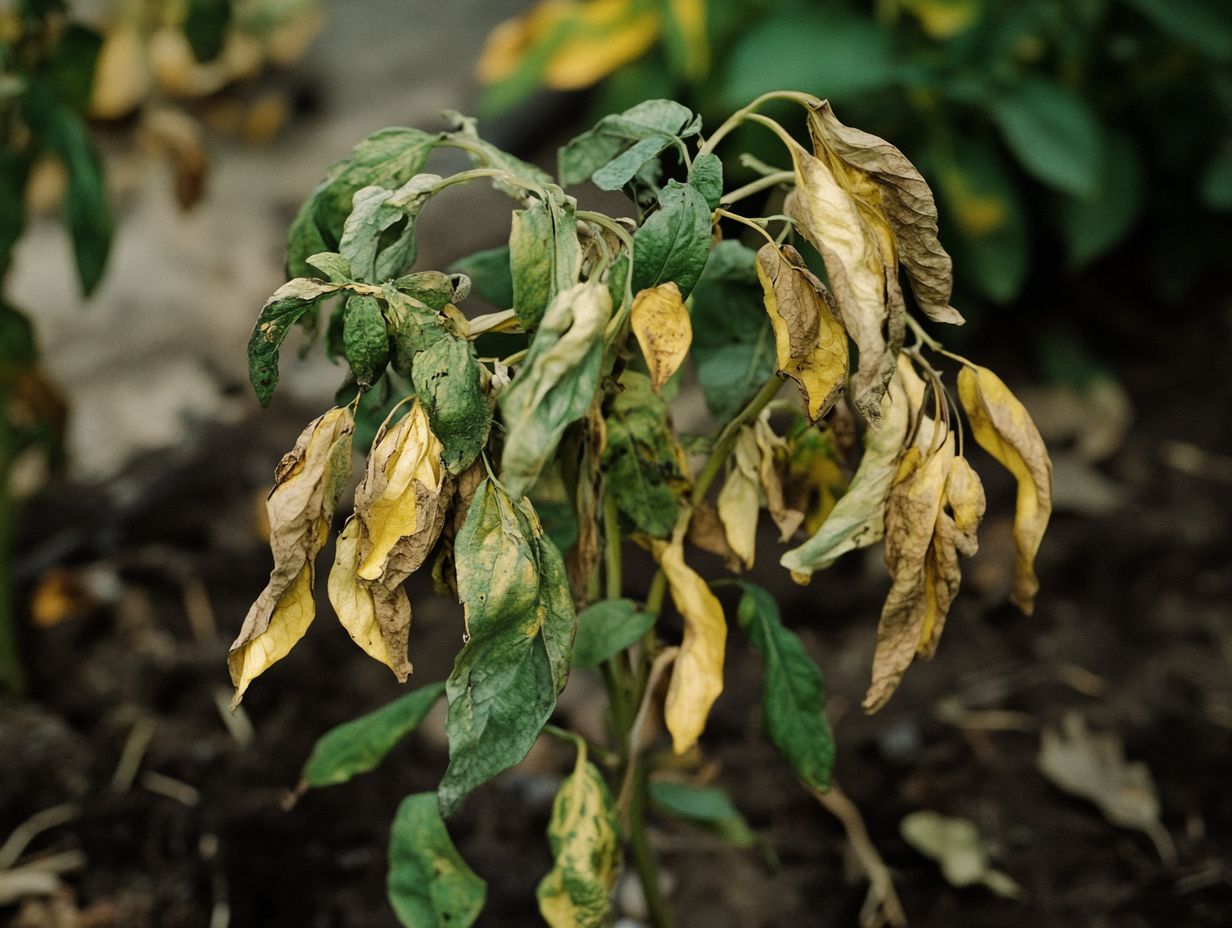
Effective treatment methods are key for addressing symptoms of plant stress, especially in plants suffering from disease or pest infestations. You can employ strategies such as targeted pesticide application, organic treatments, and enhancing soil health to alleviate non-living stress and restore harmony within the plant’s signaling pathways.
Implementing timely interventions significantly improves the chances of recovery for stressed specimens. For instance, introducing beneficial microorganisms into the soil boosts nutrient uptake and strengthens the plant’s immune system against common pathogens. Adjusting your watering habits to ensure proper drainage prevents root rot and other moisture-related issues.
Using leaf sprays that contain nutrients and growth hormones can directly address external stressors and promote resilience against future challenges. Addressing issues like wilting foliage and blackened leaves is also vital.
Each intervention is designed to effectively tackle specific stressors, ensuring that your plants have the best opportunity to thrive in their environment.
Impact of Stress on Plant Health
The impact of stress on plant health can be profound, leading to both immediate and long-term effects that influence your crop productivity. Factors such as temperature extremes and high salinity also play a significant role.
When plants endure stress, their physiological responses may result in stunted growth, diminished yields, and heightened vulnerability to diseases.
By grasping these effects, you can enhance your agricultural planning and management strategies for a more fruitful harvest. Act now to mitigate these effects for a flourishing future!
Long-Term Effects
The long-term effects of plant stress can drastically undermine overall plant health. This leads to long-lasting health issues that hinder growth and productivity. When faced with prolonged nutrient deficiencies or environmental stressors like cold stress, you may observe a decline in plant vigor.
This decline can ripple through the broader ecosystem. Understanding is key to thriving plants! Neglecting these stress factors has implications that go beyond immediate symptoms.
When plants endure recurring stresses such as water shortages, pests, or poor soil quality they can develop stunted roots and reduced photosynthetic efficiency. Ultimately, this results in lower yields.
These challenges can trigger a cascade effect, impacting nearby flora and fauna by altering habitat dynamics and diminishing available resources.
Therefore, prompt intervention and effective management techniques are essential for preserving plant resilience and ensuring a thriving ecosystem. This helps prevent negative long-term consequences that might lurk just around the corner.
How to Revive Stressed Plants
Reviving stressed plants requires a tailored approach that addresses both immediate symptoms and underlying causes of stress. By implementing best practices such as adjusting watering schedules, applying targeted fertilizers, and utilizing effective treatment methods you can restore physiological balance and promote recovery.
It’s also vital to monitor for abiotic stress factors such as air pollutants and light stress.
-
To start, closely assess the plant’s environment. Factors like light exposure, humidity, and temperature are crucial for its health. If the plant is showing signs of wilting foliage, it may benefit from a thorough watering. Ensure that excess water drains out to prevent root rot.
-
Next, consider the type of fertilizer to use. Organic options can gradually improve nutrient uptake, particularly in light of potential herbicide damage.
-
Keep an eye out for signs of pests or diseased plants. Addressing these issues promptly can significantly enhance recovery. Removing any dead or blackened leaves encourages healthier growth and vitality.
By diligently following these steps, you can effectively nurture your plant back to health. Start implementing these tips today to see your plants thrive!
Frequently Asked Questions
What are some common stress signs in plants?

Some common stress signs in plants include wilting, yellowing or browning of leaves, stunted growth, dropping of flowers or buds, and leaf curling.
What causes stress in plants, and can stress signs be reversed?
Plants can become stressed due to various factors such as inadequate sunlight, nutrient deficiencies, over or under watering, extreme temperatures, pest infestations, and diseases. Environmental conditions like high salinity and cold stress can also contribute. In most cases, stress signs can be reversed if the underlying cause is addressed. Providing adequate care and creating a suitable environment for the plant can help it recover from stress, especially if you address issues like reactive oxygen species that may arise during recovery.
How do I know if my plant is experiencing stress?
You can observe your plant for any physical changes such as discoloration or wilting of leaves. Pay attention to its growth rate; if it is not growing or thriving as it should, it may be a sign of stress.
What can I do to prevent stress in my plants?
The best way to prevent stress in plants is to maintain a consistent care routine. This includes providing suitable lighting, watering, and fertilizing as needed, along with regularly inspecting for pests and diseases.
Are there any other signs of stress in plants besides physical changes?
Yes, plants can also exhibit behavioral changes when under stress. They may close their stomata, the small openings on leaves that allow gas exchange, in an attempt to conserve water. They may also produce stress hormones, affecting their growth and development.



